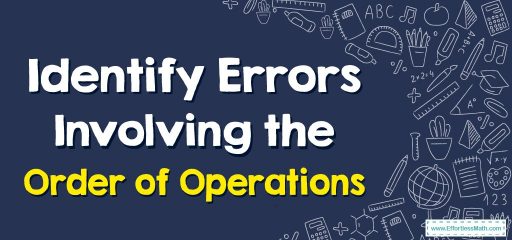How to Identify Errors Involving the Order of Operations?
When an expression has two or more mathematical operations, you need to follow the order of operation rules. You can learn these rules in this post.
[include_netrun_products_block from-products="product/6-south-carolina-sc-ready-grade-3-math-practice-tests/" product-list-class="bundle-products float-left" product-item-class="float-left" product-item-image-container-class="p-0 float-left" product-item-image-container-size="col-2" product-item-image-container-custom-style="" product-item-container-size="" product-item-add-to-cart-class="btn-accent btn-purchase-ajax" product-item-button-custom-url="{url}/?ajax-add-to-cart={id}" product-item-button-custom-url-if-not-salable="{productUrl} product-item-container-class="" product-item-element-order="image,title,purchase,price" product-item-title-size="" product-item-title-wrapper-size="col-10" product-item-title-tag="h3" product-item-title-class="mt-0" product-item-title-wrapper-class="float-left pr-0" product-item-price-size="" product-item-purchase-size="" product-item-purchase-wrapper-size="" product-item-price-wrapper-class="pr-0 float-left" product-item-price-wrapper-size="col-10" product-item-read-more-text="" product-item-add-to-cart-text="" product-item-add-to-cart-custom-attribute="title='Purchase this book with single click'" product-item-thumbnail-size="290-380" show-details="false" show-excerpt="false" paginate="false" lazy-load="true"]

When an expression has multiple operations, you have to follow this order of operation:
- First of all, do the operations inside the parentheses and the brackets.
- Then, calculate the exponents.
- After that, multiply and divide from left to right.
- And finally, add and subtract from left to right.
Errors involving the order of operations can be identified by using the acronym PEMDAS, which stands for Parentheses, Exponents, Multiplication, and Division (from left to right), and Addition and Subtraction (from left to right). Make sure to perform the operations in the correct order and to use parentheses as needed to specify the intended order of operations.
Identifying Errors Involving the Order of Operations – Examples 1
Which operation is to be done first? Calculate.
\(18÷2+8\)
Solution:
First, you have to do the division. \(18÷2=9\)
Then add. \(9+8=17\)
Identifying Errors Involving the Order of Operations – Examples 2
Which operation is to be done first? Calculate.
\(42÷\frac{6×5}{1+4}\)
Solution:
First, do the multiplication. \(6×5=30\)
Then, do the addition. \(1+4=5\)
Then divide \(30\) by \(5\). \(30÷5=6\)
And finally, divide \(42\) by \(6\). \(42÷6=8\)
Related to This Article
More math articles
- 5th Grade North Carolina End-of-Grade Math Worksheets: FREE & Printable
- Top 10 Math Books for Grade 5: Cultivating Critical Thinking in Young Mathematicians
- How to Use Memory Tricks to Memorize Math Formulas?
- 10 Most Common 6th Grade Georgia Milestones Assessment System Math Questions
- The Virtual Classroom Advantage: How Online Math Tutors Enhance Elementary Math Education
- How to Use Parallelogram Rule for Vector Addition and Subtraction
- 4th Grade NYSE Math Practice Test Questions
- Best Laptop Tables and Carts for online teaching
- How to Find Magnitude of Vectors?
- How to Solve Inverse Trigonometric Functions?


















What people say about "How to Identify Errors Involving the Order of Operations? - Effortless Math: We Help Students Learn to LOVE Mathematics"?
No one replied yet.